The Arctic Convoy Club
of New Zealand

Veterans of the Arctic Convoys 1941 -


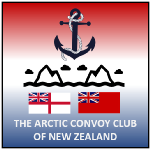
Members’ Ships : Royal Navy : A to B
Ships listed on this page:
HMS Activity; HMS Anson; HMS Apollo; HMS Bahamas; HMS Belfast; HMS Bermuda; HMS Berwick; HMS Black Prince; HMS Bluebell; and HMS Byron
Following this, Activity moved to the Arctic, escorting convoy JW 58 to Murmansk. Her aircraft—together with those from Tracker—were responsible for the sinking of U-
In May 1944, Activity spent some time at a shipyard on the Clyde for defect rectification before rejoining the Second Escort Group for escort duties. Activity escorted convoys OS 78, KMS 52, SL 158, MKS 49, OS 78, KMS 52, AL 159, MKS 50, SL 162, MK 53, KMF 33, MKF 33, OS 86, KMS 60, SL 167 and MKS 58.
In August 1944, Activity was designated as a ferry carrier. She transported aircraft, personnel and supplies to Trincomalee, Ceylon, arriving on 23 October 1944 and returning via Gibraltar, where she joined convoy MKF 36 back to the United Kingdom. Activity spent some time in a Clyde shipyard in December 1944 for defect rectification, after which she was reallocated to the East Indies Fleet and given a new pennant number, R301. She sailed with convoy KM 39 on 29 January 1945, arriving in Colombo on 20 February. Whilst en route to Sydney, Activity rescued the 92 survivors from SS Peter Silvester, an American liberty ship which had been sunk by U-
Activity departed Sydney on 24 March, bound for Colombo for duty ferrying aircraft from Cochin to Colombo. After the end of the war, Activity was sent to Singapore to support the reoccupation of Singapore. She loaded ex-
Activity was converted to a Glenearn class merchant ship by Palmers of Hebburn-
HMS Activity sailed in convoys: JW58 + RA58 + RA59. Badge date: 1943
ACCNZ Member who served on this ship:
Len Burton, Palmerston North (deceased); John M Gilbert (deceased)
HMS Activity was an escort carrier that served with the Royal Navy of the United Kingdom during the Second World War. After the war, she was sold into merchant service as the MV Breconshire, serving for over 20 years until scrapped in 1967.
HMS Activity was built at Caledon shipyards in Dundee. When construction started in 1940 she was intended to become the refrigerated cargo ship Telemachus for the Alfred Holt Line. In February 1941, she was taken over by the Ministry of War Transport and renamed Empire Activity.
In January 1942, she was requisitioned by the Admiralty for conversion to an escort carrier, now named HMS Activity and carrying pennant number D94. Following her launch in May 1942 and completion in August of that year, Activity worked up at Lamlash before going to Rosyth for rectification of defects. Entering service on 1 January 1943, Activity operated as a deck landing training carrier until October 1943, when she was sent to Liverpool for a refit before entering active service.
After her refit, Activity took part in convoy escort duties in the North Atlantic. Activity embarked 819 Naval Air Squadron on 12 January 1944, and began escort duties on the 29 January as part of the Second Escort Group. Activity was involved in the escort of convoys OS 66, KMS 40, ON 222, NS 28, SL 147, MKS 38, HX 277, KMS 43 and MKF 29 in the period to March 1944.

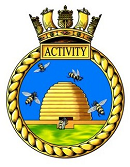

ACCNZ Member that served on this ship:
Kenneth Johnson, Tauranga (deceased)
HMS Anson was a King George V-
She was originally to have been named Jellicoe, but was renamed Anson in February 1940.
Anson saw service in the Second World War, escorting nine Russian convoys in the Arctic by December 1943. She took part in diversionary moves to draw attention away from Operation Husky in July 1943. In October the same year she took part in Operation Leader. In February 1944 she provided cover for Operation Tungsten, the successful air strike against the German battleship Tirpitz. She accepted the surrender of Japanese forces occupying Hong Kong on 15 August 1945 and after the end of the war she became the flagship of the 1st Battle Squadron of the British Pacific Fleet.
Anson arrived back in British waters on 29 July 1946, spending the next three years in active service with the post-
In the aftermath of the First World War, the Washington Naval Treaty was drawn up in 1922 in an effort to stop an arms race developing between Britain, Japan, France, Italy and the United States. This treaty limited the number of ships each nation was allowed to build and capped the displacement of all capital ships at 35,000 long tons.
These restrictions were extended in 1930 through the London Naval Treaty, however, in 1935 Japan and Italy would not agree to the Second London Naval Treaty for further armament control. Concerned by a lack of modern battleships within their navy, the Admiralty ordered the construction of a new battleship class: the King George V class.
The calibre limitation clause introduced in the Second Treaty meant that the main armament of the King George V was limited to 14-
The keel of the fourth ship of the class was laid at the Swan Hunter and Wigham Richardson Shipyard on 20 July 1937. She was originally to have been named Jellicoe, after Admiral Sir John Jellicoe, the commander of the Grand Fleet at the Battle of Jutland in 1916, but she was renamed Anson in February 1940. Anson was launched on 24 February 1940 and was completed on 22 June 1942. Completion was delayed largely because of the inclusion of fire-
Anson displaced 42,600 long tons (43,300 t) on trials in 1942 and 45,360 long tons (46,090 t) fully loaded in 1945. The ship had an overall length of 745 feet (227.1 m), a beam of 103 feet (31.4 m) and a draught of 31 feet 3 inches (9.5 m). Her designed metacentric height was 6 feet 1 inch (1.85 m) at normal load and 8 feet 1 inch (2.46 m) at deep load.
She was powered by Parsons geared steam turbines driving four propeller shafts. Steam was provided by eight Admiralty 3-
Anson's main armament was ten BL 14-
After her commissioning in 1942, Anson was sent to the Arctic Sea with most of the Home Fleet as an escort ship for multiple Russian convoys. On 12 September 1942 Anson was part of the distant covering force for Convoy QP 14, along with her sister ship HMS Duke of York, the light cruiser HMS Jamaica and the destroyers HMS Keppel, Mackay, Montrose and Bramham. On 29 December Anson provided distant cover for Convoy JW 51B along with the cruiser HMS Cumberland and the destroyers HMS Forester, Icarus and Impulsive.
On 23 and 24 January 1943 Anson provided distant cover for Convoy JW 52 along with the cruiser HMS Sheffield and the destroyers HMS Echo, Eclipse, Faulknor, Inglefield, Montrose, Queenborough, Raider and the Polish destroyer Orkan.
On 29 January, Convoy RA 52 departed from the Kola inlet, with distant cover provided by Anson, the cruiser Sheffield and the destroyers Inglefield, Oribi, Obedient and the Polish destroyer Orkan from 30 January.
In June 1942, the pre-
In July 1943 Anson took part in the diversionary moves designed to draw attention away from the preparations for Operation Husky, and in October that year, with Duke of York and the US cruiser Tuscaloosa, provided cover for Operation Leader, in which the US aircraft carrier Ranger mounted air strikes against German shipping off Norway. In February 1944, in company with the French battleship Richelieu and a force of cruisers and destroyers, Anson stood by in the same capacity while aircraft from the aircraft carrier HMS Furious carried out air strikes against German targets in Norway during Operation Bayleaf, and on 3 April she provided cover for Operation Tungsten, a successful air strike against the German battleship Tirpitz, during which she served as flagship for Vice Admiral Sir Henry Moore.
Anson was decommissioned for a refit in June 1944 and did not return to the fleet until March 1945, when she sailed with Duke of York to join the British Pacific Fleet. By the time she arrived in the theatre, hostilities were all but over. She left Sydney on 15 August for Hong Kong with Duke of York, and along with a task force of other ships from Britain and the Commonwealth, accepted the surrender of the Japanese forces occupying Hong Kong. She was also present in Tokyo Bay during the official Japanese surrender aboard the USS Missouri.
Following the war Anson was the flagship of the 1st Battle Squadron of the British Pacific Fleet and helped to liberate Hong Kong. After a brief refit, Anson sailed from Sydney to Hobart in February 1946 to collect the Duke and Duchess of Gloucester (the Duke was then Governor-
Anson arrived back in British waters on 29 July 1946 and after a short refit was returned to peacetime duties. In November 1949, Anson was placed in reserve and in 1951 she was towed to Gare Loch.[24] On 17 December 1957 she was purchased for scrap by Shipbreaking Industries, Faslane
Details of HMS Anson are available at the ship's website: www.hmsanson.co.uk
HMS Anson sailed in convoys: PQ18 + QP14 + JW51B + JW52 + JW54A + JW54B + RA52 + RA54A + RA54B. Motto: "Nil Desperandum" "Never Despair". Badge date: 1937.


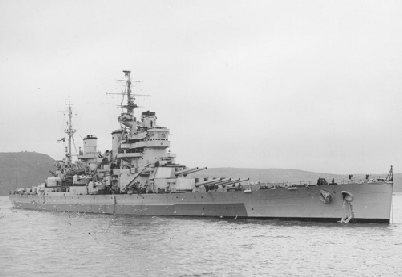
ACCNZ Member that served on this ship:
Stan Welch, Paraparaumu
HMS Apollo (M01/N01) was an Abdiel-
Ordered: 1940. Builder: Hawthorn Leslie, Hebburn. Laid down: 10 October 1941. Launched: 5 April 1943. Completed: 12 February 1944. Commissioned: 1944. Decommissioned: 1946. Recommissioned: 1951. Decommissioned: 1961. Fate: Sold for scrapping 1962. Class and type: Abdiel-
Propulsion: 4 × Admiralty 3-
In 1944, HMS Apollo was commissioned after sea trials in February 1944. Apollo joined the Home Fleet at Scapa Flow before setting out for Plymouth for mine laying operations in support of the planned invasion of France. Loading mines at Milford Haven she commenced a series of operations off the French coast of Brittany between Ushant and Île Vierge.
She was detached for duty in "Operation Neptune" and on 7 June 1944 (D-
Apollo took passage to Sheerness and then to the Tyne for repairs, which were completed in September. The ship was then transferred to Western Approaches Command, and deployed in the South-
On 24 December she was transferred to the Home Fleet for mine laying duty off Norway, operating off Utsira during January, accompanied by the destroyers Zealous and Carron. On 15 January 1945 she returned to the Western Approaches for mine laying in the Irish Sea. On 13 April Apollo rejoined the Home Fleet for a mine laying operations in the Russian Kola Inlet ("Operation Trammel") as part of "Force 5" with destroyers Opportune, Orwell and Obedient, rejoining the Home Fleet in May.
After the end of the war in Europe, Apollo sailed to Oslo in company with sister ship Ariadne and heavy cruiser Devonshire, returning the Norwegian Government-
Apollo was recommissioned in 1951 after the outbreak of the Korean War. Following a refit she joined the Home Fleet and remained in commission for the next ten years. She was paid off and returned to the Reserve HMS Apollo sailed in convoys: As a mine layer, HMS Apollo preceded Convoy JW66 to lay mines off Kola Inlet. in 1961, was put on the Disposal List the next year, and sold for breaking-
Motto: "Fortis et Benignus" "Strong and Merciful".

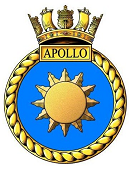
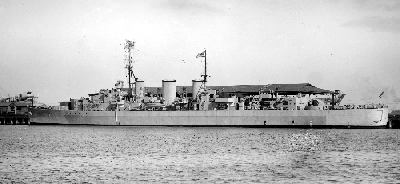
HMS Bahamas (K503)
ACCNZ Member that served on this ship: Richard Ray (deceased)
Built as Hotham (PF-
The frigate was sold to John J. Duane Co., Quincy, Mass., 16 December 1947 and scrapped.
HMS Bahamas sailed in convoys: JW62 + RA62


ACCNZ Members that served on this ship:
Frank Jones, Lower Hutt (deceased); David Boyes, Tairua (deceased)
HMS Belfast, is one of the two ships forming the final sub-
The original design included quadruple 6-
Belfast was launched on St Patrick's Day in 1938 at Harland and Wolff Shipyard in Belfast by Anne de Vere Cole, the wife of the then prime minister, Neville Chamberlain.
At that time, the budgeted overall cost of the ship was £2,141,514, of which £75,000 was for the guns and £66,500 for aircraft. She was commissioned in August 1939 under the command of Captain G A Scott DSO and assigned to the 18th Cruiser Squadron.
At the start of the Second World War the 18th Cruiser Squadron was part of the British effort to impose a naval blockade on Germany. As part of this squadron, Belfast intercepted the German liner Cap Norte on 9 October 1939 as the liner was trying to return to Germany disguised as a neutral ship. At around 1:00 a.m. on 21 November 1939 she was seriously damaged as she left the Firth of Forth, with twenty-
The mine broke the keel and wrecked the hull and machinery to such an extent that repairs at Devonport took nearly three years. She returned to service in the Home Fleet in November 1942 under the command of Captain Frederick Parham. Improvements had been made to the ship during repairs, notably bulged amidships to improve her stability and fitting the latest radar and fire control; her displacement had risen from 11,175 to 11,553 tons, making her Britain's heaviest cruiser.
She was made flagship of the 10th Cruiser Squadron, under Rear-
Between 1959-
The ship left Singapore on 26 March 1962 for the UK where she made a final visit to Belfast and after an exercise in Mediterranean was paid off on 24 August 1963. Following a campaign led by Rear-
HMS Belfast sailed in convoys: JW53 + JW54b + JW55a + JW55b + RA53 + RA54a + RA54b + RA55a. Motto: "Pro Tanto Quid Retribuamus" "We Give As Good As We Get". Badge date: 1937.

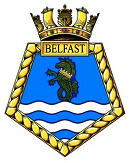

Belfast was almost continuously in action for the next five weeks, firing thousands of rounds from her 6– and 4–inch batteries in support of troops until the battlefront moved out of range inland. Her final salvo in the European war was fired on 8 July during Operation Charnwood, the battle to capture Caen, when she engaged German positions together with the battleship HMS Rodney and the monitor HMS Roberts. Two days later she returned to Devonport for a short refit for service in the Far East, and joined Operation Zipper, which was intended to expel the Japanese from Malaya but turned into a relief operation following the Japanese surrender.
During the last days of the war in Europe she was spotted in the North Sea by a German submarine without noticing the enemy vessel. The German commander decided not to fire, as the war was almost over. Belfast served in the Korean War, supporting United Nations land forces by naval bombardment. In July 1952 she was hit by a Communist battery, killing one man and wounding four.
ACCNZ Members that served on this ship:
Alan McLauchlan (deceased); Arch Jelley, OBE CNZM, Auckland; Dugald McKenzie, Blenheim (deceased); Maurice Newman OBE DSC (deceased); and Louis McCleary (deceased)
HMS Bermuda (C52) was a Crown Colony class cruiser of the British Royal Navy during the mid-
Through 1942, the Bermuda would participate in the North Africa campaign, including Operation Torch. The following year she would serve in both the Atlantic and Arctic. In 1945, the Bermuda was deployed to the Pacific. Following the war, the Bermuda continued her service. In 1953, she assisted the Greek island of Zakynthos when it was struck by a severe earthquake. Greek officials would later comment, "we Greeks have a long-
The Bermuda made several visits to her namesake, where she was presented with a number of silver objects, including a large bell -
HMS Bermuda sailed in convoys: JW52 + JW54a + JW54b + JW56a + JW56b + RA51 + RA52 + RA54b + RA56. Motto: "Coeur de Lion" " Lionheart". Badge date: 1942

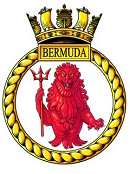
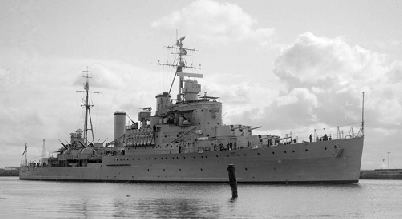
ACCNZ Members that served on this ship:
Derek Whitwam, Lower Hutt; Dennis Whitehead (deceased), Napier
HMS Berwick, a Royal Navy Kent class -
At the outbreak of the Second World War HMS Berwick was flagship 8th Cruiser Squadron, America and West Indies Station. She departed Bermuda on 7 November 1939 and arrived at Portsmouth on 14 November to join the 1st Cruiser Squadron, Home Fleet, during January 1940. On 2 March, the German merchant ship Wolfsburg was intercepted off Iceland by HMS Berwick. The Wolfsburg scuttled herself and Berwick had to sink the wreck.
On 6 March 1940, Berwick intercepted the Uruguay off Iceland which also scuttled and was sunk by Berwick's gunfire. Then, during April 1940, Berwick took part in the operations connected with the Norway Campaign. When it was decided to send British forces to Iceland, a Royal Marine battalion was embarked on 7 May 1940 at Greenock in Berwick and Glasgow, and was landed at Reykjavik on the morning of 10 May 1940 (Operation "Fork").
After other minor operations with the Home Fleet, HMS Berwick left the Clyde on 1 November 1940 for the Mediterranean arriving at Malta on 10 November where she disembarked troops from England. On the way she took part in Operation "Crack", a Fleet Air Arm attack on Cagliari. On 11 November 1940, Berwick escorted the carrier Illustrious in the successful raid against the Italian battle fleet in Taranto Harbour. Later, she also escorted convoys between Egypt and Greece.
On 27 November she took part in the action between the Mediterranean and Italian fleets off Spartivento, Sardinia during which she received two direct hits from 8-
On 21 December 1940, Berwick departed Gibraltar to meet and escort Convoy WS5A towards the Cape. This was the convoy that was attacked on the morning of Christmas Day by the heavy cruiser Admiral Hipper. The convoy scattered and only one transport, the Empire Trooper, was damaged and took refuge in the Azores. During action with the Admiral Hipper, HMS Berwick received four hits, one putting an 8-
Crew on HMS Berwick en-
This operation was delayed twenty four hours owing to unsuitable weather. Two merchant vessels were destroyed, one tanker hit, one ship and one escort vessel damaged. Another successful Home Fleet operation "Lombard" and air strike in the Aalesund area took place on 1 June 1944.
Between 22 and 29 August 1944 the Berwick again assisted as covering force for Operation "Goodwood", an air carrier operation against the Tirpitz which coincided with the passage of the Russian convoy JW59. For the voyage of the Prime Minister and his staff from the Clyde to Halifax, Nova Scotia, for the Allied Conference at Quebec, the cruiser Kent left Scapa on 4 September 1944 to provide fast cover for the passage of RMS Queen Mary (Operation "Octagon"). The Kent escorted her as far as the Azores, when the Berwick, having refuelled there, continued the escort to Halifax.
From 1 November 1944, HMS Berwick participated in Convoy JW61A. Two liners Scythia and Empress of Australia sailed from Liverpool on 31 October 1944 carrying 10,213 Soviet nationals -
On the night of 28-
Crew of HMS Berwick in Halifax, Nova Scotia, after escorting RMS Queen Mary with Winston Churchill on board to the Quebec Conference code named "Operation Octagon "
Battle honours: Atlantic (1939); Norway (1940); Spartivento (1940); Arctic (1941-


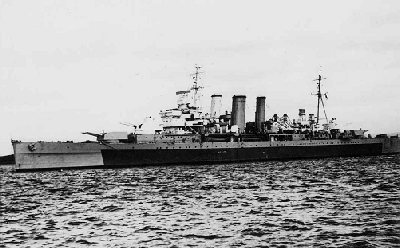
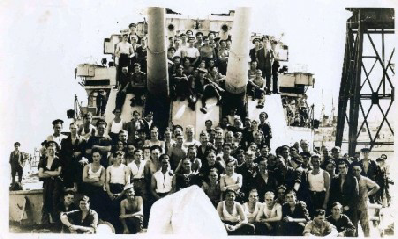

On 31 February 1942 the Admiral Scheer (pocket battleship) and Prinz Eugen (8-
On 7 July 1943, the Home Fleet left Scapa Flow for a demonstration off the coast of Norway (Operation "Camera") so as to distract the enemy and pin its forces during the invasion of Sicily (Operation "Husky") which was about to begin. The cruisers Norfolk and Berwick left Iceland on 6 July to cooperate in this demonstration, returning there on 10 July 1943. On 24 February 1944 Berwick left Scapa Flow to provide covering force for the North Russian convoy JW57 and in March for the returning convoy RA57. On the evening of 3 May, the Berwick left Scapa for another Home Fleet operation "Croquet", an air strike off Norway by aircraft from HMS Furious and Searcher.
ACCNZ Member that served on this ship:
George Gosling (deceased); Murray R Kerr (deceased)
Donald Matheson
HMS Black Prince was a Dido-
The cruiser was docked for modernisation in 1947, but in April, her sailors walked off the ship as part of a series of mutinies in the RNZN. The shortage of manpower resulting from these mutinies meant that the modernisation had to be cancelled, and Black Prince was placed in reserve until 1953. She returned to service after refitting and standardisation of the secondary armament with 40mm twin and single guns. The ship was decommissioned again two years later, and she was returned to the Royal Navy in 1961. Black Prince did not re-
She was a modified Dido design, sometimes called Dido Group 2, or the Bellona subgroup with only four 5.25-
Black Prince was named after Prince Edward (1330-
During the Normandy landings, she was part of Force "A" of Task Force 125 in support of Utah Beach. Task Force 125 at this time consisted of the battleship USS Nevada, the cruisers USS Quincy, USS Tuscaloosa, Black Prince, the monitor HMS Erebus and several destroyers and destroyer escorts. Black Prince's target was the battery at Morsalines. In August, she moved to the Mediterranean for the invasion of Southern France. She was then sent to Aegean waters in September 1944. On 8 September, Black Prince arrived in Alexandria, Egypt, where she was ordered to sweep the area around Scarpanto and the Gulf of Salonica. On one occasion she bombarded the airfield at Maleme on the island of Crete to prevent German aircraft from taking off.
On 21 November 1944, Black Prince left Alexandria, passed through the Suez Canal into the Red Sea and then on into the Indian Ocean. She arrived at Colombo in Ceylon on 30 November to join the East Indies Fleet where she covered the aircraft carrier raids against Japanese oil installations and airfields in Sumatra and Malaya (Operation Meridian).
On 16 January 1945, she sailed as part of the British Pacific Fleet, seeing action off Okinawa and in the final bombardments of the Japanese mainland before withdrawing to repossess Hong Kong in September.
After the Japanese surrender, she remained in the Far East, and was transferred to the Royal New Zealand Navy on 25 May 1946. During 1947, the cruiser was docked for modernisation, but this was cancelled following a series of mutinies in April (which included the sailors from Black Prince), as the RNZN no longer had the manpower to operate her. Black Prince was placed in reserve. Work on reactivating the ship began in January 1952, to reduce crew the two multiple Pom Pom AA mounts were temporarily removed and eight of the unique RNZN 40 mm single electric Toadstool CIWS, installed, in place of Mk 5 twin Oerilikons and she was recommissioned in February 1953. In the same year she took part in the Fleet Review to celebrate the Coronation of Queen Elizabeth II.
The cruiser was decommissioned again in August 1955, and after the decision in the UK 1957 Defence Review to strike the remaining Royal Navy Dido and Improved Dido's as too outdated to be used again or modernized, Black Prince was reduced to extended 3rd class reserve, and used as an accommodation ship for refitting warships and spare part source for Royalist's 1960-
She was sold for scrap in March 1962 and towed from Auckland on 5 April to the Mitsui & Company, Osaka breakage yards, Japan, by the tug Benten Maru, arriving there on 2 May 1962.
Sailed in convoys: JW57 + RA57. Motto: "With High Courage". Badge date: 1943


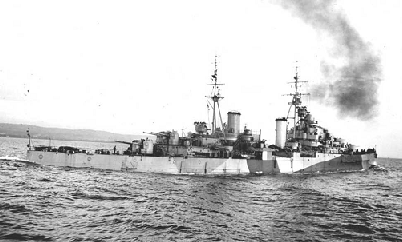
ACCNZ Member that served on this ship:
Chris King, Wellington; Norman Batterham, Auckland (deceased)
HMS Bluebell was a Flower-
After commissioning and sea trials in July 1940, Bluebell was deployed on Atlantic convoy escort duties. Commanded by Lieutenant-
In January 1941 Bluebell was attached to the 5th Escort Group, Western Approaches Command, based at Liverpool, to escort Atlantic convoys, transferring in September to the 37th Escort Group for the defence of convoys between Gibraltar and ports in West Africa. She returned to the UK in July 1942 to refit, and was assigned for service on the Russian Convoys.
In September she sailed to Iceland to join the escort of Convoy PQ 18 to Arkhangelsk, returning in November, and resuming Atlantic convoy escort duties in December and January. In February 1943 she joined the escort of Convoy JW 53 from Loch Ewe to Kola Inlet, returning in March to resume duties in the Western Approaches.
In June 1943 Bluebell was sent to the Mediterranean, and in early July was part of the escort for assault convoys during the initial landings in the Allied invasion of Sicily, remaining in the Mediterranean for further convoy escort duties until August when she returned to the Western Approaches.
Between February and April 1944 she escorted Russian Convoys JW 57 and JW 58, and in May was transferred to Escort Group 143 to prepare for the invasion of Normandy. On 6 June she formed part of Convoy ECL1 escorting LSTs from the Bristol Channel to the landing beaches, then escorted follow-
After further convoy defence and interception duties, on 2 February 1945 she was attached to the escort for Russian Convoy JW 64. After arriving at Kola Inlet she took part in anti-
HMS Bluebell sailed in convoys: PQ18 + QP15 + JW53 + JW57 + JW58 + JW59 + JW64 + RA57 + RA58 + RA59a + RA64. Motto: "Ring true". Badge date: 1921

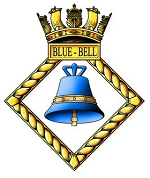
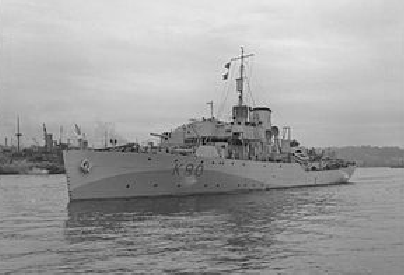
ACCNZ Member that served on this ship:
Thomas Grainger (deceased), Tauranga
HMS Byron was a Captain class (Type 2) frigate with pennant number K508. The vessel was commissioned on 30 October 1943 and was returned to the US Navy on 24 November 1945 and later scrapped.
HMS Byron sailed in convoys: JW57 + JW61 + RA61

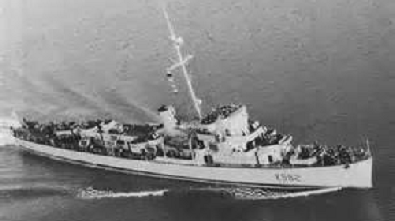
Links to other members’ ships:
HMS Caesar; SS Cape Race; HMS Caprice; HMS Chiltern; HMS Dasher; HMS Diadem; SS Dolabella; HMS Drury; HMS Duke of York; HMS Echo; SS El Almirante; SS Eldena; SS Elona; SS Empire Beaumont; SS Empire Galliard; SS Empire Garrick; HMS Forester; HMS Furious; HMS Glasgow; HMS Goodall; SS Harmatris; HMS Howe; HMS Implacable; SS Induna; HMS Jamaica; HMS Javelin; HMS Kent; HMS Kenya; HMS Keppel; HMS King George V; RFA Laurelwood; HMS Loch Insh; HMS Loch Killin; HMS London; HMS Lookout; HMS Magpie; HMS Malcolm; HMS Musketeer; HMS Nabob; HMS Nelson; HMS Nigeria; HMS Norfolk; HMS Obedient; SS Ocean Freedom; HMS Offa; HMS Onslaught; HMS Onslow; HMS Palomares; HMS Queen; HMS Renown; HMS Rodney; SS Samgara; SS San Ambrosio; HMS Sheffield; HMS Speedwell; HMS Speedy; HMS Striker; HMS Suffolk; HMS Tartar; HMS Tracker; HMS Trinidad; HMS Victorious; HMS Vindex; HMS Volage; HMS Wakeful; and HMS Zealous

This site uses images in SVG file format.
For best viewing results, please ensure you are using the latest version of your web browser.
This website is owned by The Arctic Convoy Club of New Zealand © 2004 -
This page updated January 2024
| About Us |
| About Arctic Convoys |
| Convoy Kiwis |
| Greetings Exchange |
| Affiliations |
| Links |
| Topical Items |
| Decorations |
| Membership |
| My Story |
| Newsletter |
| Online Application Convoy Membership |
| Convoy Numbers |
| Merchant Navy Ships |
| Royal Fleet Auxiliary |
| Royal Navy Ships A - B |
| Royal Navy Ships C - F |
| Royal Navy Ships G - L |
| Royal Navy Ships M - O |
| Royal Navy Ships P - T |
| Royal Navy Ships U - Z |
| Obituaries |
| Wellington Memorials |
